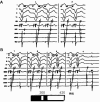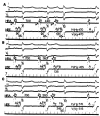Clinical and experimental evidence of supernormal excitability and conduction
- PMID: 24827801
- PMCID: PMC4040872
- DOI: 10.2174/1573403x1003140522161728
Clinical and experimental evidence of supernormal excitability and conduction
Abstract
True supernormality of excitability and conduction has been demonstrated in normal Purkinje fibers in in vitro studies. In the clinical setting, supernormality of conduction is manifested better than expected. This phenomenon is much more common than previously thought, particularly in the presence of certain clinical conditions. If a careful scanning of the cardiac cycle is performed on all patients with intermittent bundle branch block and second degree or advanced infranodal AV block, accessory pathways and mulfunctioning pacemakers, it is anticipated that a much larger amount of supernormal excitability and conduction will be unmasked.
Figures























References
-
- Hoff HE, Nahum LM. The supernormal period in the mammalian ventricle. Am J Physiol. 1938;124:591–5.
-
- Spear JF, Moore EN. Supernormal excitability and conduction in the His-Purkinje system of the dog. Circ Res. 1974;35:782–92. - PubMed
Publication types
MeSH terms
LinkOut - more resources
Full Text Sources
Other Literature Sources
Medical
